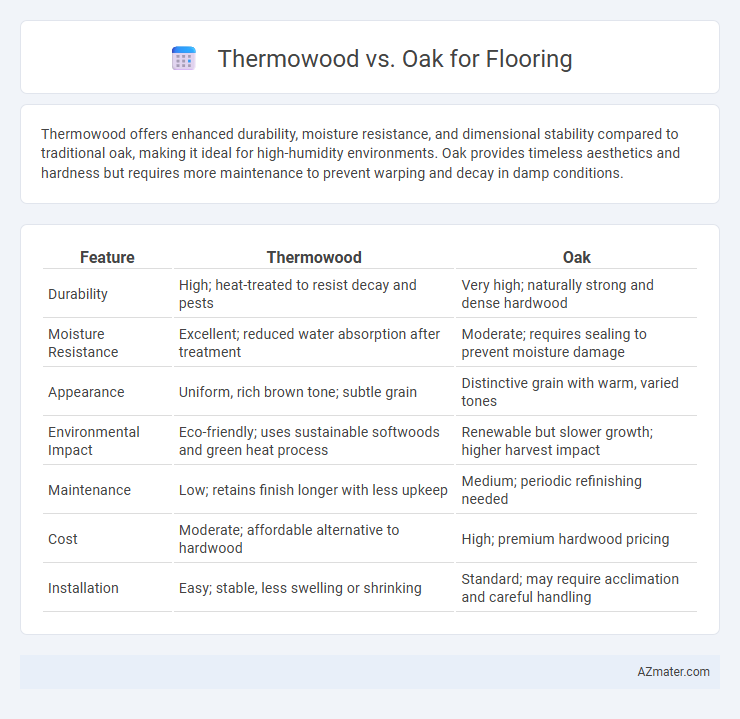Thermowood offers enhanced durability, moisture resistance, and dimensional stability compared to traditional oak, making it ideal for high-humidity environments. Oak provides timeless aesthetics and hardness but requires more maintenance to prevent warping and decay in damp conditions.
Table of Comparison
| Feature | Thermowood | Oak |
|---|---|---|
| Durability | High; heat-treated to resist decay and pests | Very high; naturally strong and dense hardwood |
| Moisture Resistance | Excellent; reduced water absorption after treatment | Moderate; requires sealing to prevent moisture damage |
| Appearance | Uniform, rich brown tone; subtle grain | Distinctive grain with warm, varied tones |
| Environmental Impact | Eco-friendly; uses sustainable softwoods and green heat process | Renewable but slower growth; higher harvest impact |
| Maintenance | Low; retains finish longer with less upkeep | Medium; periodic refinishing needed |
| Cost | Moderate; affordable alternative to hardwood | High; premium hardwood pricing |
| Installation | Easy; stable, less swelling or shrinking | Standard; may require acclimation and careful handling |
Introduction to Thermowood and Oak Flooring
Thermowood flooring is created by heat-treating softwoods like pine or spruce to enhance durability, stability, and resistance to decay. Oak flooring, known for its strength and rich grain patterns, is a hardwood choice offering exceptional hardness and long-lasting performance. Comparing Thermowood and Oak involves assessing factors such as moisture resistance, maintenance needs, aesthetic qualities, and environmental impact.
Key Differences Between Thermowood and Oak
Thermowood is a heat-treated softwood that offers enhanced durability, dimensional stability, and resistance to decay compared to natural oak, which is a dense hardwood known for its strength and classic appearance. Oak flooring provides a unique grain pattern and natural hardness ideal for high-traffic areas, while Thermowood's thermal modification process improves its moisture resistance and makes it less prone to warping and insect damage. Cost-wise, Thermowood is generally more affordable and eco-friendly due to its sustainable treatment process, whereas oak is prized for its long-lasting, elegant finish but often requires more maintenance.
Appearance and Aesthetic Comparison
Thermowood flooring offers a rich, uniform brown tone with subtle variations, highlighting the wood grain through its heat treatment process, which creates a smooth, modern appearance. Oak flooring showcases a natural, classic aesthetic, characterized by prominent grain patterns and a warm range from light beige to deep amber, enhancing traditional and rustic interiors. The choice between Thermowood and Oak hinges on preference for contemporary, consistent coloration versus timeless, textured visual appeal.
Durability and Lifespan
Thermowood offers enhanced durability compared to traditional oak flooring due to its heat-treated process that increases resistance to moisture, decay, and insect damage. Oak, known for its natural hardness and density, provides a long lifespan with strong wear resistance but requires regular maintenance to prevent moisture-related issues. Both materials exhibit impressive longevity, with Thermowood's specifically engineered treatment extending its lifespan in damp environments, making it ideal for areas prone to humidity.
Resistance to Moisture and Humidity
Thermowood flooring offers superior resistance to moisture and humidity compared to traditional oak due to its heat-treated process that stabilizes the wood and reduces water absorption. Oak, while durable and strong, is more prone to swelling and warping in high humidity environments, making it less ideal for moisture-prone areas. Thermowood's enhanced dimensional stability and natural decay resistance make it a preferred choice for floors exposed to damp conditions and fluctuating humidity levels.
Installation Process and Methods
Thermowood flooring involves a thermal modification process that enhances its stability and durability, allowing for easier installation with fewer expansion joints compared to traditional wood. Oak flooring requires careful acclimatization and moisture control during installation to prevent warping and gaps, often necessitating specialized adhesives or nails depending on the subfloor type. Both materials benefit from professional installation techniques, but Thermowood's dimensional stability typically reduces post-installation maintenance and adjustment needs.
Maintenance and Care Requirements
Thermowood flooring requires minimal maintenance due to its enhanced durability and natural resistance to decay, making it less susceptible to swelling, warping, and insect damage compared to oak. Oak flooring demands regular sealing and polishing to protect its porous surface from moisture and scratches, ensuring its longevity and appearance are preserved. Both materials benefit from routine cleaning, but Thermowood's treated surface reduces the need for frequent refinishing and specialized care products.
Environmental Impact and Sustainability
Thermowood is produced through a heat treatment process that enhances wood durability without chemical additives, resulting in lower environmental impact compared to traditional treatments. Oak flooring, while naturally durable, requires more intensive forestry practices and longer growth cycles, affecting sustainability. Choosing Thermowood supports reduced carbon emissions and promotes sustainable forestry by maximizing the use of fast-growing pine species.
Cost Analysis: Thermowood vs Oak
Thermowood flooring generally costs 15-30% less than traditional oak, making it a budget-friendly option for durable wood floors. Oak, known for its premium quality and natural grain, commands higher prices ranging from $8 to $14 per square foot, while Thermowood is typically priced between $6 and $10 per square foot. Maintenance costs for Thermowood are lower due to its enhanced resistance to moisture and decay, potentially reducing long-term expenses compared to oak flooring.
Which Is Better: Thermowood or Oak for Flooring?
Thermowood offers enhanced durability and resistance to moisture due to its heat treatment process, making it ideal for environments with high humidity or temperature variations. Oak, a traditional hardwood, provides exceptional hardness and timeless aesthetic appeal, but it requires more maintenance to guard against moisture damage. Choosing between Thermowood and Oak depends on priorities such as durability, maintenance, and environmental conditions, with Thermowood excelling in stability and Oak favored for its classic beauty and hardness.

Infographic: Thermowood vs Oak for Flooring
 azmater.com
azmater.com